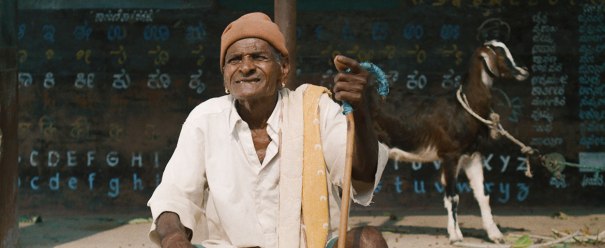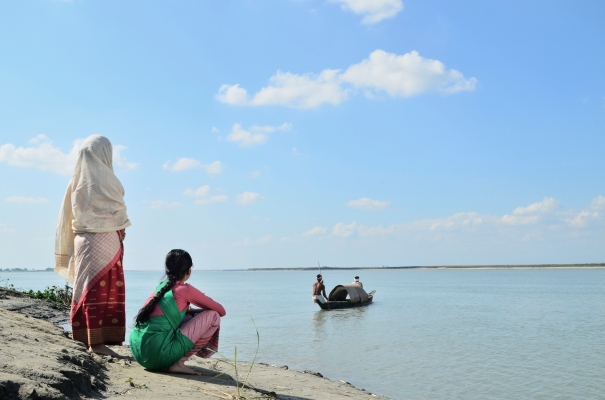The regional cinema of India, away from the glitz of Bollywood and bustle of Westernized city-life and in the isolated patches of huts and farms of the country, revealed a cinema which is starting to examine village-life with a keen eye. This trend started a little while ago, but more and more filmmakers from India are turning their cameras to capturing tall fables, inspirational stories, and timely socio-economic examinations of life in the rural heartland of India’s villages. Here are three such movies which caught my attention this year:

UMRIKA (thick-accented Indian pronunciation of “America”)
Prashant Nair’s Umrika, like many independent Hindi features from India had an incredibly difficult time finding distribution because of the over-saturation of mainstream garbage cinema Bollywood continues to pump out like a vomiting gutter-pipe. Yet, thanks to the revelation of online-streaming media and the newly sprouting avenues as well as rave reviews from the Sundance Film Festival, Nair’s little film found a home in Netflix. God bless.
Umrika uses Indian village life’s conservative traditionalism and isolationism as a comedic device. Clearly Nair’s film is meant for the urban-dwelling Indian or the innocent Westerner discovering Indian cinema for the first time. As a village family’s oldest son ventures off to America (they call it, in their heavy Indian accent, “Umrika”), they fantasize about a land of plenty that they cannot even fathom. He sends back letters and photos of strange things incredibly alien to these isolated villagers. A scene shows them holding up a picture of a muscular meaty American beef cattle and comparing it to their own Indian gai comprised of just flimsy skin and bones. These comical moments are relatable because they create the dichotomy that we already hold in our minds between Umrika and the rural poor of India. However, once the son’s letters stop coming, we know something is wrong and the story shifts to a more urban environment as the younger son, Ramakand goes searching for him. Here all our prejudices of rural life are confronted with the corruption of money amongst the urban elite. The idea of Umrika changes from being a land of plenty to a myth shrouded by deceit and phoniness. Umrika is an innocent film, and its ambition exceeds its grasp, but it does get one thinking about how we define our place between where we come from and where we ultimately go?

THITHI (English: “Funeral”)
Part of what made Raam Reddy’s debut film Thithi so compelling is its ability to give a real account of village life ongoings and procedures through a fully unfiltered lens. Yes, there have been other “village” films to come out, particularly those from Bollywood such as Peepli Live, but the forced media-eye encounter of that film was still a bit decorated and polished. Here, we get Karnataka in its utter primal state. Even the semblance of a love story that starts bubbling in the tall grass, one which could have gone the way to a orchestrated first class crescendo like in Manjule’s Sairat, instead only teases and taunts and ultimately fizzes out to the everyday monotony of village worklife. The film’s story centers around two sons of a dead centenarian. But the story or the ultimate capture of one son’s lie and the other’s redemption in the climax of the film is a narrative which trudges us along. Even the main character, Channegowda’s, horrific revelation of his father’s rape is a disturbing plot-twist that gives depth to his character, but is still a side-note in the cinematic landscape that Reddy paints with such an authentic brush. The real treasure lies in the minute details of a vibrant community that is hidden in the plains, away from an India quickly undergoing what the United States did in the late 1800’s. It is a nation on the cusp of something great… but there is still a life away from all of that, wandering aimlessly in the bushels, chugging a bottle of whiskey, just waiting to die.

KOTHANODI (English: “River of Fables”)
Kothanodi might be the most disturbing Indian film I’ve ever seen. There have been unnerving films, like Kaun or Phobia and depressing films like Matrubhoomi, but Bhaskar Hazarika has tapped into something incredibly unique here. This film is weird, strange, and left utterly uncomfortable about the whole ordeal. Kothanodi is a film comprised of four mythical tales which revolve around a stream. A woman is followed by a mysterious fruit which she inexplicably gave birth to… a husband and his uncle kill a woman’s three children and bury them in the forest, but when the fourth one is born, she decides to take a stand… a young girl is left alone with her stepmother, whose mind is possessed by a demon… and a greedy couple plan to marry their daughter to a King Python in hopes the snake will bless her with fortune and riches.
This is a hard movie to shake because its stories are unrelentingly bleak. It’s also uncompromising in its regressive “village politics”. Many of these stories are old and their lessons may seem outdated in today’s age, yet its commendable Hazarika doesn’t bother to “adapt” them for a modern audience. He leaves them as is, a relic of the past and presents them as a “take it or leave it” situation.
The film isn’t a horror film, but it has a very unnerving feeling about it. It wouldn’t surprise me one bit if Hazarika is an avid fan of Kanedo Shindo because there are so many moments that bring back visions of a Onibaba or Kuroneko. The ominous music, rustling tall grass hiding and revealing characters and secrets, wild eyed possessed women and a disturbing entity brewing through each story. It’s a unique film in its ability to merge traditional Indian dramatization with a cold surrealism that is indescribable except for how it made me feel… uncomfortable.